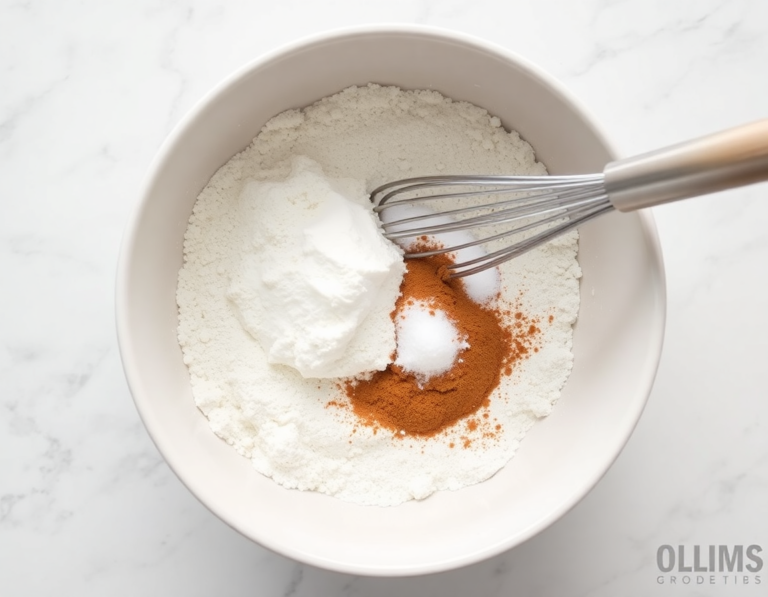
Ah, oatmeal cookies! They always remind me of my grandmother’s cozy kitchen where the air was perpetually filled with the scent of cinnamon and warm oats—like a comforting hug.
With their perfect chewiness and just the right hint of sweetness, these cookies are like little bites of nostalgia. Can we ever have enough?
I think not.
Steps
- Begin by beating the softened butter in a mixing bowl with an electric mixer for about 30 seconds. Add both the brown and granulated sugars, and continue beating until the mixture is light and fluffy, ensuring you scrape down the sides of the bowl as needed.
- Incorporate the eggs into the butter and sugar mixture one at a time, mixing well after each addition. Stir in the vanilla extract until fully combined.
- In a separate bowl, whisk together the flour, cornstarch, baking soda, salt, and ground cinnamon. Slowly add this dry mixture to the wet mixture, ensuring everything is well integrated.
- Gradually fold the oats into the combined mixture, making sure they are evenly distributed. If desired, this is the stage to add raisins or chocolate chips.
- Cover the dough with plastic wrap and refrigerate for at least 30 minutes, but it can also be chilled for up to three days. Before baking, preheat your oven to 375°F (190°C) and prepare baking sheets with parchment paper.
- Shape the dough into balls approximately the size of 2 tablespoons and place them on the prepared baking sheets, leaving at least 2 inches between each. Optionally, smooth the dough balls between your palms for more uniform cookies.
- Bake the cookies for 10-12 minutes, until the edges are slightly golden. The centers may appear a bit undercooked, but they will finish baking as they cool on the baking sheet.
- Allow the cookies to cool completely on the baking sheet before serving. Enjoy the soft and chewy texture of your oatmeal cookies!

Ingredients
- 1 cup (226 g) unsalted butter, softened
- 1 cup (200 g) light brown sugar, firmly packed
- ½ cup (100 g) granulated sugar
- 2 large eggs, preferably at room temperature
- 1 ½ teaspoons vanilla extract
- 1 ¾ cups (215 g) all-purpose flour
- 2 teaspoons cornstarch (or cornflour in the UK)
- 1 teaspoon baking soda
- ¾ teaspoon table salt
- ¾ teaspoon ground cinnamon
- 3 cups (285 g) old-fashioned rolled oats
- 1 ½ cups of chocolate chips, chopped nuts, or raisins (optional)
Nutritional Values
Calories: 4800kcal | Carbohydrates: 648g | Protein: 72g | Fat: 216g | Saturated Fat: 120g | Polyunsaturated Fat: 24g | Monounsaturated Fat: 72g | Cholesterol: 888mg | Sodium: 3312mg | Potassium: N/A | Fiber: 24g | Sugar: 312g | Vitamin A: 1776IU | Calcium: N/A | Iron: 72mg
FAQ
- Can I add extras like raisins, chocolate chips, or nuts to the oatmeal cookies?
- Absolutely! You can add about 1 ½ cups of your choice of raisins, chocolate chips, or nuts to the dough. Mix them in with a wooden spoon or spatula after incorporating the oats.
- Are quick oats a good substitute for old-fashioned oats in this recipe?
- Yes, quick oats can be used as a substitute, although the cookies might be slightly less chewy and hearty. Use the same amount as you would old-fashioned oats.
- How can I ensure my oatmeal cookies remain chewy?
- To keep your cookies soft and chewy, make sure not to overbake them. Store the cookies in an airtight container at room temperature and enjoy them within five days for the best texture.
- What can I do if I don’t have cornstarch for the recipe?
- If you don’t have cornstarch, you can substitute it with an equal amount of flour. The cookies may be a bit flatter and less chewy, but they will still be delicious.
Tips
- Cream Butter and Sugar Thoroughly: Ensure you cream the butter and sugars well to incorporate air into the batter, which helps achieve the perfect cookie texture. Aim for a light and fluffy mixture, using an electric or stand mixer for the best results.
- Use a Kitchen Scale for Precision: Weighing your ingredients with a kitchen scale ensures accuracy and consistency in baking. This method can save time on cleaning since you won’t need to use multiple measuring cups.
- Monitor Oven Temperature: Keep an oven thermometer in the center of your oven to ensure accurate temperature readings, as many ovens can run hotter or cooler than indicated. Always bake cookies on the center rack unless specified otherwise.
- Slightly Underbake for Chewiness: Remove cookies from the oven when the edges are set but the centers appear slightly underdone. Allow them to cool on the baking sheet, where they will continue to cook, resulting in cookies that remain soft and chewy.
Equipment
- Stand Mixer or Electric Beater – For creaming the butter and sugars efficiently.
- Kitchen Scale – To weigh ingredients accurately for consistent results.
- Oven Thermometer – To ensure your oven is at the correct temperature.
- Cookie Sheets – If you don’t already have them, for baking the cookies.
- Parchment Paper – To line the cookie sheets and prevent sticking.